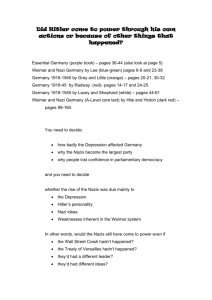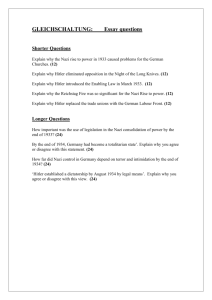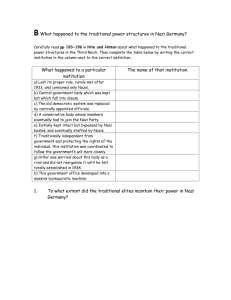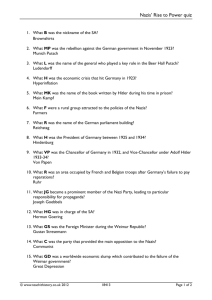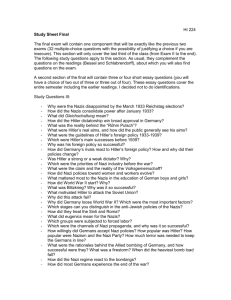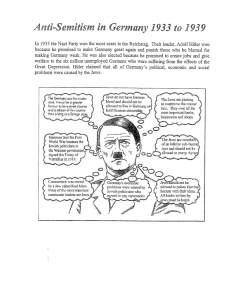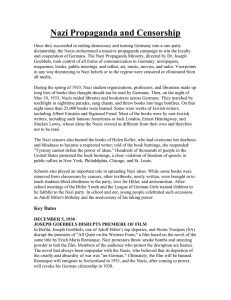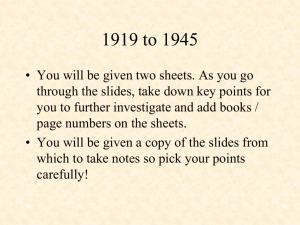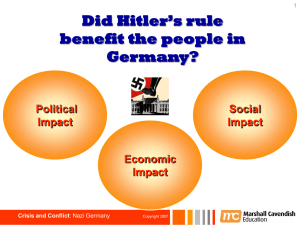The Nazis Party in the 1920s
advertisement
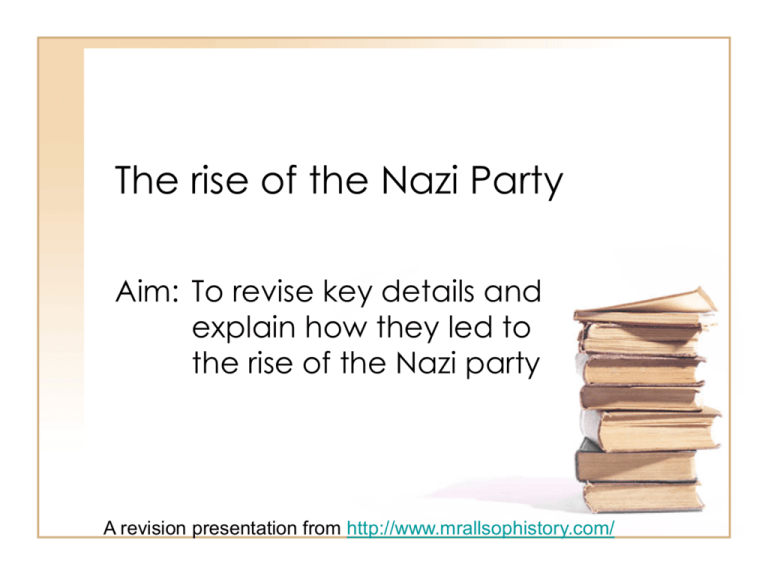
The rise of the Nazi Party Aim: To revise key details and explain how they led to the rise of the Nazi party A revision presentation from http://www.mrallsophistory.com/ Overview • The Nazi Party was formed in 1919 • Hitler joined the party shortly after its inception • Germany was in a state of disarray after the First World War • There were many extremist groups in Germany at the time 1919-1923 • Many Germans felt that they had been ‘Stabbed in the back’ by the Weimar politicians by signing the Treaty of Versailles. Many of them joined Right Wing groups such as the Freikorps or the Nazi party. • People feared a Communist revolution in Germany. They looked to Right Wing groups to act against this. • Right Wing groups gained popularity by saying that they would not adhere to the Treaty of Versailles. How did the Nazi party gain support in this period? • Military uniforms demonstrated strength at a time when the government was weak • Use of force against communists and Trade unionists was popular with businesses • Populist policies and rhetoric were employed to discredit opponents and develop support. • References to traditional values and reminders of ‘Who was to blame’ for the economic crisis built support. 1923: Munich/Beer Hall Putsch • By 1923 the Nazi party had gained much support in Bavaria. Now firmly under the control of Adolf Hitler the group attempted to seize control force. • Despite having many sympathisers the coup failed and Hitler was imprisoned. • The failure of the Munich Putsch demonstrates that power needs to be taken through legal means. Regrouping • Whilst in prison Hitler analysed, developed and refined the party’s strategy • Shift to winning electoral support • Development of propaganda tools • Attempts to win support of big business 1924-1929 • Focus on traditional values • Built fear of Left Wing groups • Continued use of military imagery • BUT the success of Stressemann’s policies meant little support for extremists 1929-1932: A Change in Fortunes • Wall Street Crash leads to end of effective financial assistance from USA • Unemployment rises rapidly • Hyperinflation recurs • Threat of Communism increases • Coalition government fails to address problems successfully Into government • Nazis used force to prevent uprisings • Rhetoric played on peoples fears • Big Business won over through radical economic plans • Emphasis placed on military power won support of many soldiers and traditionalists • Weak coalition governments enabled Nazis to gain political strength • Propaganda and shows of might impressed the masses Into government • Electoral support rose significantly from 1930 onwards to make the Nazis the largest single party in the Reichstag • Continuing economic crisis led to break down of coalitions • Aging and ineffective president Hindenburg increasingly reliant upon Article 48 (rule without needing to consult the Reichstag) • Germany in desperate need of a strong leader Into government • Invited to become Chancellor by politicians who believed that Hitler could be manipulated • The February 1933 Reichstag Fire was used to scapegoat Communists as enemies of Germany • In the March 1933 election the Nazis had a majority in the Reichstag • By 1933 the Nazi Party’s rise to power was complete Hitler’s Rise to Power Click video to view. Rise to power: an overview • Strong leadership • Determination • Popular Rhetoric and Hitler’s capabilities as a public speaker • Weakness of Coalition government • Wall Street Crash and the consequent economic collapse • Support of significant businessmen • Disruption of extremist opponents • Fear of Communism Practice question • Explain how the following together contributed to the rise of the Nazi Party up to 1933: – The economic depression from 1929 – The Nazi Party’s use of propaganda – The weaknesses of the Weimar Republic [10]
